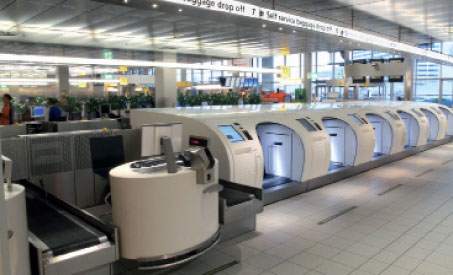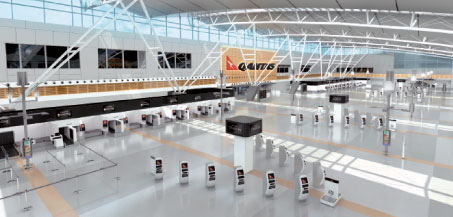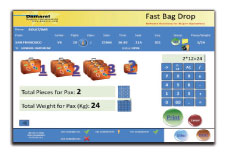
Amsterdam Airport Schiphol provides one of Europe’s best reference sites for self-service bag drop and 12 units are in place in Departure Hall 2.
Although the pioneers of the industry started piloting self-service bag drop five years ago, it is still very much a new phenomenon. Among the latest airports to announce an intention to implement such systems is Bologna Airport, which is expected to complete the installation of 14 units by mid-2013. Aéroports de Paris has also successfully installed a system at Paris-Orly – which will soon be extended to Paris-Charles de Gaulle – while London-Heathrow intends to undertake a pilot.
Amsterdam Airport Schiphol provides one of Europe’s best reference sites for self-service bag drop and earlier this year, 6 new self-service bag drop systems were introduced in Departure Hall 2, taking the total number to 12. The implementation of the system followed close collaboration between the airport and based carrier KLM.
“We have worked very well with the airport because we both had the same goal, the same objective – to keep on growing within the same airport building,” explained Victor Vaessen, Manager Product Development, KLM.
The benefits of allowing passengers to take charge of the check-in and bag drop process themselves are clear. For the airline it means fewer agents are needed, passenger processing is faster and congestion around check-in desks is reduced. For the airport, it enhances the check-in capacity, reduces operational costs and allows for the optimisation of existing space.
One or two-step?

ICM Airport Technics has supplied its self-service baggage drop system to Qantas as part of the airline’s Next Generation Check-In programme.
Vanderlande awarded DFW contract
Dallas/Fort Worth International Airport (DFW) has announced Vanderlande Industries as the official Operations and Maintenance provider for its Terminal E Inline Baggage Handling System (BHS) as well as its 35 Passenger Boarding Bridges (PBB). The Operations & Maintenance contract valued at over $11.5 million will be in place over the next four years, and includes a team of almost 50 persons. In addition to maintaining the legacy BHS and 35 PBBs in Terminal E, Vanderlande Industries will also be responsible for maintaining the new BHS scheduled to be installed over the next four years.
Vanderlande Industries will also introduce its VIBES remote monitoring and Business Process Intelligence (BPI) software and hardware. This revolutionary tool will be installed on the existing baggage handling system as well as the new system once phased in. The Vanderlande Industries Baggage Execution System (VIBES) is a standard control solution for complete operational management of baggage handling systems. VIBES gives insight into the baggage process from end-to-end, including planning, monitoring, optimisation and execution.
However, while all self-service bag drop installations are built on the premise of empowering the passenger, airports and airlines must decide whether to implement a one- or two-step solution. While the former allows the process of printing and attaching bag tags and depositing the bag into the system to be completed in a single transaction, the latter requires the passenger to print their bag tags at a self-service kiosk, before depositing their bag at a separate location.
As Vaessen explained, the implementation at Amsterdam Airport Schiphol makes use of the one-step process. “There were two main reasons for using one-step. The first was our home check-in passengers. More than 50% of our passengers check-in at home, so we didn’t want all of these to still have to go to a kiosk when they arrive at the airport and we simply wouldn’t have enough room for all of the kiosks. The one-step or two-step process depends very much on the infrastructure of the airport.”
The two-step process, is however, also popular. ICM Airport Technics, which has supplied its system to Qantas as part of the Next Generation Check-In programme, utilises the two-step process and Duncan Watson, the company’s Head of Global Marketing Operations, explained that the process “maximises the available real estate for the airport departures concourse”. He added: “The two-stage process results in significant savings in both expenditure and footprint. It is better for the passenger to spend two minutes in Area A and subsequently 30 seconds in Area B, compared to two-and-a-half minutes in a single stage process.”
As well as the implementation by Qantas, ICM Airport Technics’ two-step solution is in place at a number of other locations. In fact, a total of 84 units have been implemented across 8 airport terminals – 6 in Australia and 2 at London-Heathrow.
Home printed bag tags
While the benefits of each process have clear merits that can be applied individually to each location, there is already a focus on how the overall baggage process can be further improved.
Two solutions that are gaining traction are permanent bag tags – which are already being utilised by Qantas for frequent fliers – and home printed bag tags, which can be printed and attached by passengers before they even leave home.
“We do believe in home printed and permanent bag tags,” explained KLM’s Vaessen. “We’ve run some pilots already with home printed bag tags and we’re working on an industry standard with IATA (International Air Transport Association). We hope to carry out some operational pilots next year.”
While improvements to the baggage process have been sought for a number of years to make cost savings and improve the passenger experience, airports, airlines and suppliers appear to be in agreement that self-service could well provide the best solution. As home printed and permanent bag tags are now developed to support self-service bag drop infrastructure, automated bag drop is likely to be one of the key areas of industry investment in the short and medium term.
The drop zone

Damarel has extended its existing airline DCS Babel emulators to include highly focused bag drop profiles.
The fast bag drop counter is a given at most airports these days. The benefits of fast bag drop to both passengers and airlines are considerable as queues are reduced, terminal space is saved and staffing levels are decreased. However, without the right technology and procedures, the fast bag drop will not function well, queues will accumulate and passenger satisfaction will plummet.
The recent generation of self-service bag drop kiosks goes some way to solving this issue but at a cost that is prohibitive to most airlines and airports. Damarel’s approach has centred on optimising the agent attended process, automating as much as possible without adding additional hardware cost. Caroline Cross, Marketing Coordinator at Damarel, outlined how this works in practice. “Airlines and ground handlers want to provide the best bag drop experience possible, within the constraints laid down by the airport infrastructure. By building a new streamlined process into the systems they are already using, we can achieve the benefits they are looking for without the need for costly hardware or untried technology.”
In essence, Damarel has extended its existing airline DCS Babel emulators to include highly focused bag drop profiles, restricting agent interaction to a series of simple steps that automatically identifies passengers, retrieves the PNR and issues bags. This solution needs only the existing common use devices and no specialist hardware, making it available for all airlines. Cross added: “This is a simple, cost-effective way of dramatically improving the bag drop process that will appeal to most airlines. It doesn’t require major infrastructure investment or wholesale staff retraining.”








What is situation right now. What kind of improvement procedures are needed. How are they going to work If a bag tag is used home and what about the control of the 20, 30 Kgs suitcases and bags?